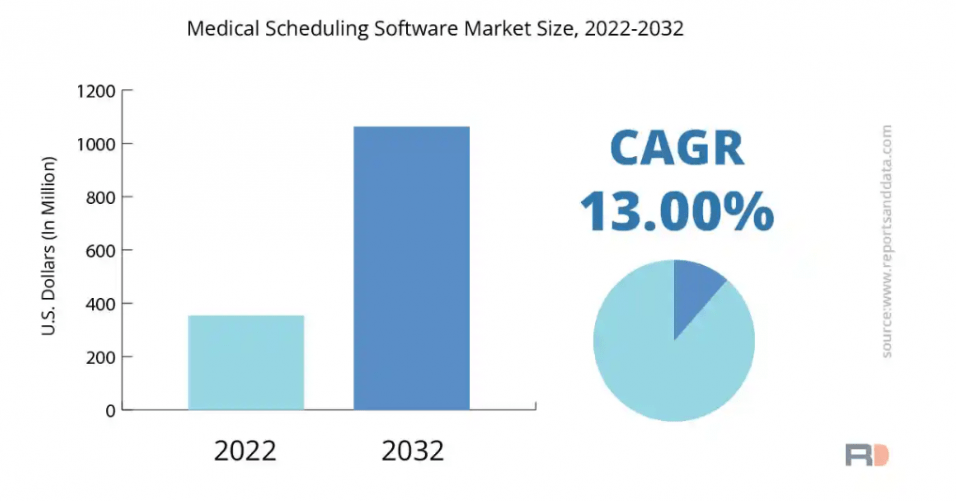
A doctor appointment application is a software program or app that allows patients to easily schedule, cancel, or reschedule appointments with their healthcare providers. These applications aim to improve care access and efficiency for patients and medical practices.
Who Needs a Doctor Appointment App?
There are a few key groups that can benefit greatly from using a doctor appointment application:
Patients
Patients are the primary users of doctor appointment apps. Whether they are receiving care at a hospital, clinic, or private practice, many patients now view a doctor-on-demand app as essential for any healthcare provider. At a compound annual growth rate of 13%, the medical scheduling software market is projected to reach USD 612.5 million by 2026.
These apps allow users to schedule appointments themselves rather than relying on calling the doctor's office during strict business hours. The apps provide 24/7 self-service access.
Key benefits for patients include:
Convenience to book appointments anytime, anywhere via mobile
Reminders and notifications about upcoming appointments
Easy cancellation and rescheduling
Integration with calendar and maps for direction
Doctors & Health Practices
A doctor appointment application development can optimize scheduling for providers, allowing them to offer more patient-centric access to care.
Key benefits for providers include:
Reduced no-shows since patients have reminders
Automated waitlist to fill cancellations
Insights into patient demand patterns
Lower administrative costs
These applications take on much of the practice's appointment coordination workload, allowing it to focus on patient care.
Urgent Care Clinics
Urgent care clinics can greatly benefit from doctor appointment apps. These walk-in medical centers need to manage patient flow carefully. Apps allow people to digitally hold a place in line rather than physically waiting in the clinic.
Some key advantages of appointment apps for urgent care include:
Preventing long wait times
Allowing patients to wait at home or run errands until appointment time
Optimizing staffing as patient volumes vary
Telehealth Providers
Telemedicine apps very commonly incorporate appointment-scheduling features. These allow users to book a direct video visit with a doctor in the app.
Appointment functionality integrated with telehealth apps provides:
Seamless booking experience
TeleVisit reminders and queue information
Follow-ups after the video call
As telehealth grows, doctor appointment apps developed by such powerful teams as Langate will likely be bundled into these virtual care platforms.
Top Features of Doctor Appointment Applications
Doctor appointment apps share some universal features, although offerings can vary across platforms. Below are some of the most important capabilities:
Self-Scheduling
The core functionality of a doctor appointment app is self-service scheduling. Patients can select a date/time and book an appointment 24/7. Apps connect to the provider's calendar in real-time.
Advanced options include the ability to specify appointment type (annual physical, flu shot, procedure consult, etc.) and provider preference if a practice has multiple doctors.
Mobile Accessibility
Convenience and on-the-go access are key advantages of doctor apps over calling the medical office. The apps should have native iOS and Android apps.
The user interface and user experience need to be mobile-friendly. Mobile functionality like SMS reminders is also useful.
Calendar Integration
The doctor app should allow patients to integrate booked appointments into their calendars, like iCalendar/Google Calendar.
Calendar integration enables users to track upcoming appointments easily through apps they already use and rely on.
Notifications and Reminders
Custom reminders leading up to the appointment help reduce no-shows. Patients can choose email or SMS reminders.
Some apps also notify about possible openings for rescheduling. The reminders can include the doctor's address and contact information.
Waitlist Management
An appointment waitlist allows patients to book last-minute cancellations or be notified when new spots open up.
Apps may have a free public waitlist and reserved premium slots for established patients willing to pay more.
Payment Processing
Many appointment apps allow patients to pay medical bills, copays, or appointment deposits through the platform.
Payment integration streamlines the checkout process rather than forcing separate payment procedures. Secure storage of payment information also facilitates easier future payments.
Telehealth Integration
As telemedicine grows, doctor appointment apps will likely become part of these virtual care platforms. Patients may be able to schedule in-person or video visits via the same portal.
Appointment apps for telehealth can facilitate e-prescriptions, remote monitoring, and follow-ups after virtual urgent care visits.
Why Are Doctor Appointment Apps Becoming So Popular?
Doctor appointment applications are rising in popularity among both patients and healthcare providers.
General statistics on appointment scheduling show that 46% of appointments are made online by clients, and 54% are made by staff.
Staff members no longer have to spend as much time managing and scheduling appointments over the phone or through other channels.
A few key trends are driving the adoption of these apps:
Patient Consumerization of Healthcare
Like many other industries, healthcare is experiencing a consumerization revolution. Patients are acting more like customers. They expect convenient digital access and tools like doctor appointment apps.
Mobile Health Momentum
Mobile health apps are exploding. Apps that facilitate finding doctors, scheduling appointments, or accessing records have become patient necessities.
Telehealth Acceleration
Patients expect healthcare apps to offer video visits and regular appointment self-scheduling as virtual care usage grows. Integrated telehealth and appointment management are likely.
Practice Efficiency Pressures
Doctors and health systems face tremendous efficiency pressures from reduced reimbursements and administrative burdens. Appointment apps help optimize schedules and lower costs.
COVID-19 Impacts
The pandemic radically changed patient preferences towards contactless, digital-first healthcare. Appointment apps enable this through remote self-service scheduling.
Powerful demographic and technological shifts will likely continue the rise of doctor appointment applications. These platforms are highly useful for both patients and providers.
Selecting the Best Doctor Appointment Application
With many appointment apps emerging, it can get confusing to evaluate the options. Here is a checklist of key criteria to assess when selecting an application:
Core Features
Simple self-scheduling and cancellation
Calendar integration
Configurable reminders
Waitlist support
User Experience
Clean mobile-optimized interface
Easy account setup
Fast performance
Patient Convenience
Saved payment methods
Integrated telehealth
Access health records
Provider Integration
Real-time sync with practice schedules
Analytics and reports
Flexible customization
Security
HIPAA-compliant
Encrypted data
Multifactor authentication
Customer Support
Responsive online ticketing
Setup assistance
Active user community
Cost
Free or freemium for patients
Reasonable monthly fees for practices
The best doctor appointment apps balance patient convenience with healthcare provider productivity. Assessing options against the above framework can help identify the right platform.
Key Players in Doctor Appointment Applications
The market for doctor appointment and medical practice management apps continues to grow. Though still an emerging space, some leaders have cemented strong positions. Below are several noteworthy companies in this category:
Zocdoc
It is a platform for booking a doctor's appointment that is used by many people. It is a free service for patients and a paid service for providers. It is popular for the variety of practice opportunities.
Doctible
An end-to-end practice management solution with strong appointment app features. Used by thousands of healthcare organizations like Urgent-MD Management, Trilogy Health & Wellness Clinic, Maxhealth Medical Associates, Shelbyville Physical Therapy, and Lubbock Fort Medicine.
DrChrono
Leading medical practice platform with appointment self-scheduling among many capabilities. Seamless EHR integration.
TheraNest
The premier appointment scheduling service in mental healthcare. Specifically developed for therapists, psychologists, and psychiatrists.
However, there are still opportunities for new players in the doctor appointment app ecosystem. Still, based on the current usage of the apps by patients and medical practices, the above companies dominate the market.
The Future of Doctor Appointment Applications
Mobile applications that connect patients with doctors have yet to reach their full potential, but they have great potential to revolutionize the way people schedule their appointments with doctors.
Here are some potential areas of evolution for these platforms:
Telehealth Integration - Appointment apps could become integrated virtual care hubs for full-service telemedicine along with scheduling.
Predictive Scheduling - Advanced apps may be able to use health records and AI to predict optimal scheduling times.
Automated Check-In - Apps may have the ability for patients to digitally self-check in upon arrival at the clinic.
Decentralized Platforms - Blockchain technology could enable decentralized appointment platforms.
Care Coordination - Apps could help manage referrals, second opinions, lab tests, and other care coordination.
Rx Management - Prescription requesting, ordering, delivery, and tracking functionality may come to future appointment apps.
Dynamic Scheduling - Real-time schedule changes and openings could be pushed to patients via appointment apps.
Medical scheduling, however, is still in its infancy regarding the transformation enabled by appointment applications. However, the growth trajectory indicates promising innovation that, in the long run, may benefit both patients and the healthcare industry.


